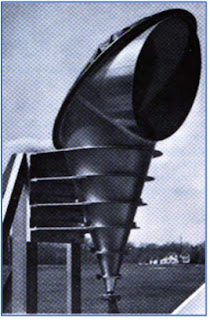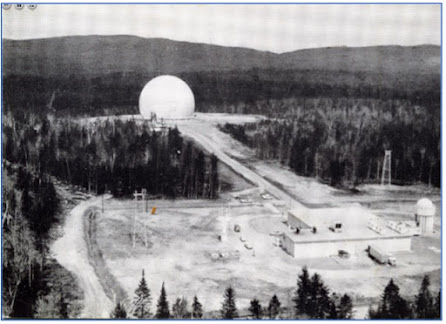Telstar-1 was an international effort providing trans-Atlantic telephone, data, and television services between the US and Europe. Built by Bell Labs, it was launched by AT&T on July 10, 1962. The 34” diameter, 170 lb. satellite was launched into orbit from Cape Canaveral using NASA’s Delta rocket.
Furthermore, the US location also required a short path to Europe, Andover also met this criteria and would be closer to Europe than other location in the US. The ES also needed to be close to the AT&T transcontinental microwave system for interconnection with the rest of the United States.
Note that the Black Mountain [Figute-4] communications tower, currently owned by SBA tower company, continues to be used today for Public Safety radio communications by the Oxford County 9-1-1 Regional Dispatch Center, and other cellular wireless companies.
Figure-4 Andover Earth Station Link to Black Mountain

Connecting Telstar for overseas calls from the US mainland was facilitated by AT&T Long Lines, a large network of microwave tower sites delivering long distance telephone service to cities and towns nationwide. AT&T Long Lines was the outgrowth of the telegraph system beginning in the 1850s, consisting of conductors on wooden poles.
Beginning in 1911, and several decades thereafter, the AT&T Long Lines network provided wired long distance calls. With the progression of technology, however, AT&T Long Lines converted their landline system to wireless, replacing it with microwave radio relay towers [Figure-10].
In 1947, AT&T implemented the first microwave system between NYC and Boston, using eight tower sites. From this point on, they built an enormous transcontinental microwave system carrying long distance telephone calls. The first coast-to-coast call, using microwave radio, was made on August 17, 1951.
Microwave networks require line-of-sight between towers. This necessitates a large network infrastructure to deliver long distance phone service to all cities and towns in the US. A local microwave tower site would be interconnected to the local Bell Central Office using cable [or microwave].
Many 200’ to 300’ towers, about 15 to 25 miles apart, were constructed to relay telephone traffic throughout the country.
This robust communications network, built by Western Electric, was relied on not only by the US public, but by the US government and the military for many of its communications needs. AT&T telecommunications was considered critical military infrastructure, especially during the cold war.
As AT&T built the network, some equipment shelters were built underground like bomb shelters; some built to withstand nuclear blast EMP; some to withstand nuclear detonation, they all included emergency generators, while some locations were equipped to house technical staff needed to run the facility, the intent to keep the system operational if attacked.
Telstar was short lived. Its brief life was about eight months; as its destiny was essentially settled by unintended circumstances, Telstar was launched in the middle of a turbulent electromagnetic radiation storm.
The 1960s was also an important time in US history where the US experimented and tested nuclear bombs over the Pacific Ocean. Ironically, the day before Telstar-1 was launched, the U.S. set off a nuclear detonation test in the Pacific at an altitude of 250-miles. The blast was equal to a 1.4-megaton explosion, generating a massive electromagnetic pulse sending high energy electrons into space.
Besides being the first telecom satellite, Telstar was now an unintended experiment on the effects of a nuclear blast on electronics – in this case silicon transistors that were used in Telstar’s electronics.
On the day of the launch, Telstar could not be activated as some transistors had failed due to the nuclear test. Fortunately, engineers at the Andover ES were able to recover operation by interrupting power on Telstar, which in effect reset the transistors and electronics on board.
The next day they were able to successfully broadcast a picture of the American flag from Andover to the station in Pleumeur-Bodou, France.
However, by December 1962, Telstar’s transistor problems continued, and the satellite stopped working again. For the next month engineers worked feverishly to recover Telstar operations with some success as the satellite functioned again; but the electronics were unquestionably damaged, and AT&T decided to shut down Telstar for good on Feb. 21, 1963.
Today, nearly sixty years after the shutdown, Telstar is still orbiting the earth, and will do so for the next 200 years or so. Eventually, gravity will pull it back to the earth’s atmosphere where it will burn up.
In 1982, the Department of Justice broke up AT&T’s monopoly, allowing telecommunications competition. Microwave systems were continued to be built by other telecom companies, like Microwave Communications Inc. [MCI], allowing the technology and networks to grow. New generation of Satellites and Fiber Optics networks were being developed and implemented as primary voice and data transmission medium for the new telecom industries, especially in urban areas. They provided greater capacity at greater speeds. Eventually, AT&T Long Lines began shutting down their towers in the 1990s’
As for the Earth Station in Andover, ME, it continues to operate today. The original dome and antenna were taken down in 1985 as new technology replaced first generation equipment.
Originally, there were plans to construct up to 50 Telstar satellites to form a constellation of low orbiting satellites, so that one would always be within sight of an earth station. However, geosynchronous satellites were more favorable as they rotated with the earth, making it look like the satellite was ‘parked’ in orbit and always within sight. This position is 22,300 miles above the equator.
LEOs are far from being gone, they are expected to continue to grow into the next decade. Companies like Starlink [Space-X], currently have about 3,271 LEOs in orbit providing internet services worldwide.











